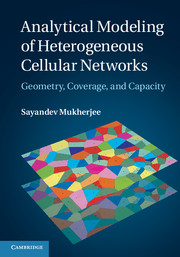Book contents
- Frontmatter
- Contents
- Preface
- Acknowledgemants
- List of notation
- List of acronyms and abbreviations
- 1 Introduction
- 2 Structure of the SINR calculation problem
- 3 Poisson point processes
- 4 SINR analysis for a single tier with fixed power
- 5 SINR analysis for multiple tiers with fixed powers
- 6 SINR analysis with power control
- 7 Spectral and energy efficiency analysis
- 8 Closing thoughts: future heterogeneous networks
- Appendix A Some common probability distributions
- Appendix B HCNs in LTE
- References
- Author index
- Subject index
4 - SINR analysis for a single tier with fixed power
Published online by Cambridge University Press: 18 December 2013
- Frontmatter
- Contents
- Preface
- Acknowledgemants
- List of notation
- List of acronyms and abbreviations
- 1 Introduction
- 2 Structure of the SINR calculation problem
- 3 Poisson point processes
- 4 SINR analysis for a single tier with fixed power
- 5 SINR analysis for multiple tiers with fixed powers
- 6 SINR analysis with power control
- 7 Spectral and energy efficiency analysis
- 8 Closing thoughts: future heterogeneous networks
- Appendix A Some common probability distributions
- Appendix B HCNs in LTE
- References
- Author index
- Subject index
Summary
Introduction
We are interested in the distribution of instantaneous SINR at an arbitrary user location in a multi-tier deployment of BSs, where the locations of the BSs of each tier are modeled as points of a PPP. In this chapter, we restrict ourselves to a simpler problem, namely a single-tier BS deployment. We show how to derive the distribution of the SINR at the user location (assumed, without loss of generality, to be the origin) under different serving BS selection criteria (also called association rules, because they determine the BSs to which the user associates itself). The derivations will use results from the theory of Poisson point processes in Chapter 3. We shall also require some advanced results from the theory of PPPs that were not covered in Chapter 3, and these results will be introduced as needed in this chapter.
Before we study the distribution of instantaneous SINR at a user, let us begin with an even simpler problem, namely the distribution of the instantaneous total received power at the user from all BSs in the tier.
Distribution of total interference power in a single-tier BS deployment
PPP of received powers at user from BSs in a tier
Consider a marked PPP Φ with intensity function λ(·, ·), where the marks associated with the points (x, y) of λ are i.i.d. with common PDF fH(·), say.
- Type
- Chapter
- Information
- Analytical Modeling of Heterogeneous Cellular NetworksGeometry, Coverage, and Capacity, pp. 35 - 70Publisher: Cambridge University PressPrint publication year: 2014



